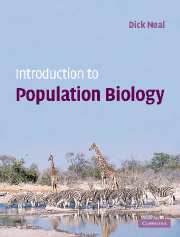Book contents
- Frontmatter
- Contents
- Preface
- Acknowledgements
- PART I Evolution by natural selection
- PART II Simple population growth models and their simulation
- PART III Population genetics and evolution
- PART IV Demography
- PART V Interactions between species, and the behaviour of individuals
- Chapter 17 Interspecific competition and amensalism
- Chapter 18 Predation
- Chapter 19 Animal behaviour, natural selection and altruistic traits
- Chapter 20 Sexual selection and mating systems
- Chapter 21 Epilogue
- Glossary
- Solutions to problems
- References
- Index
Chapter 21 - Epilogue
- Frontmatter
- Contents
- Preface
- Acknowledgements
- PART I Evolution by natural selection
- PART II Simple population growth models and their simulation
- PART III Population genetics and evolution
- PART IV Demography
- PART V Interactions between species, and the behaviour of individuals
- Chapter 17 Interspecific competition and amensalism
- Chapter 18 Predation
- Chapter 19 Animal behaviour, natural selection and altruistic traits
- Chapter 20 Sexual selection and mating systems
- Chapter 21 Epilogue
- Glossary
- Solutions to problems
- References
- Index
Summary
We have come to the end of a journey during which we have introduced the four main areas of population biology. By now you will be realizing that a full understanding of the subject requires a grasp of the basic principles of evolution, population genetics, population ecology and behavioural ecology. A true synthesis of these areas is demanding because there are so many connections to be made as we shift between genetics, ecology and behaviour, and then try to make sense of it all from a Darwinian perspective. Nevertheless, it is important to attempt some form of synthesis because we will obtain a much more complete understanding of whatever process or phenomenon we are studying. Consider the following two examples.
First, the interaction between predators and their prey. There are numerous models of the growth of predator and prey populations that try to explain how predators affect the numbers and growth of their prey populations, and vice versa. Although these models help us to understand something about this type of interaction, a lot of questions remain. Why do some predators switch from eating one type of prey to another, and why can one predator limit the numbers of its prey but another cannot? Answers to these types of questions requires knowledge of an array of different factors. For example, the behaviour of both predators and their prey affect who is eaten and at what rates; the rates of energy acquisition versus energy expenditure may vary for different prey items, and predators may vary their diet accordingly; and genetic variation amongst the prey may make some more susceptible to predation than others.
- Type
- Chapter
- Information
- Introduction to Population Biology , pp. 354 - 356Publisher: Cambridge University PressPrint publication year: 2003



